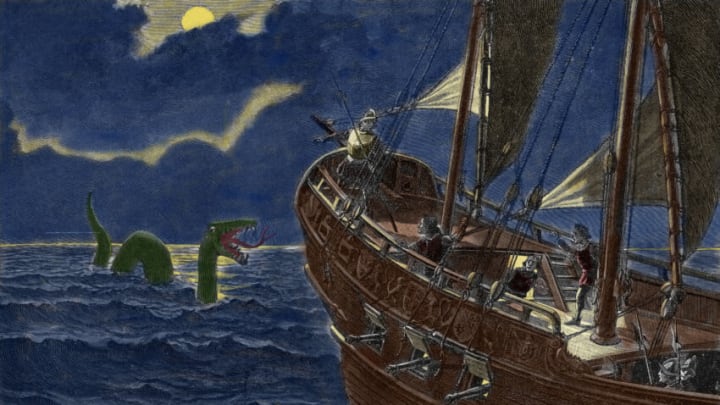It’s time for another North American water-based cryptid on Call of the Cryptid. Specifically, we’re going over the legend of Canada’s Cadborosaurus, or “Caddy.” Unlike some of these myths we’ve covered at Call of the Cryptid, it seems some people are true believers when it comes to Caddy. The name comes from mixing Cadboro Bay in Greater Victoria, British Columbia, and “saurus,” which is commonly associated with dinosaurs. Though Caddy has plenty of accounts over the years, it’s not clear if the hypothetical creature is considered more of a deadly menace than merely a territorial protector.
What are some of these accounts? Well, according to one source, back in 1933, a lawyer and his wife out yachting purportedly reported spotting a “horrible serpent with the head of a camel.” This same iffy Wiki source claims a few duck hunters had a fallen duck snatched from them by this same camel-headed snake thing. Though I just referred to this source as “iffy,” it should be noted that mythological creatures tend to have plenty of questionable sources. It’s really to be expected.
Caddy / Cadborosaurus accounts; Believable or BS?

Caddy has been assessed by a few relatively mainstream sources. For example, The Scientific American (which certainly sounds more credible) suggests that a baby “cadborosaur” written about by a “Captain William Hagelund” in 1968 is actually a pipefish. Those quaint, seahorse-like fish apparently do exist in Canadian waters. Of course, those creatures are quite small, so if it was mistakenly called a Cadborosaurus, it would have to be a baby Cadborosaurus.
In another online article, self-described “writer, naturalist and photographer” Kelly Brenner cites LeBlond and Bousfield’s book, Cadborosaurus, with an observation that was apparently reported from way back in 1897: “I saw ahead of us what I thought was a piece of driftwood. On getting closer, I noticed it was moving towards us…What we could see was an object…sticking out of the water about two feet. When within a few feet of it the end uncoiled and raised a long neck about five feet out of the water with a head like a snake’s on it.” Credible or not, I’m sharing the link anyway!
Mysterious sea creatures like to stay mysterious..wouldn’t you?
“Caddy” has been a topic on the TV series Animal X. Season 1, Episode 13 of that series deals with 3 different creatures: Cadborosaurus, Red Heifer, and “Alien Big Cats.” This video (provided below if you scroll) goes over various alleged sightings, including a pilot named Don who claimed to see “two humps sticking out of the water” and Dr. Edward Bousfield (who apparently has some real credentials yet the series referred to as a “cryptozoologist”).
Bousfield appears to have really believed in Caddy, and there appears to be no tourist promotional motive for his doing so. Then again, his belief in it doesn’t mean it is real, or that it truly is what people believe it to be (in some cases, carcasses purported to be Caddy are likely to have been sharks or whales).
Keeping the legend alive
The water-based horse-headed snake thing sounds similar to other sea serpent cryptids we’ve covered here (and here). Though we might respect national borders and call this a Canadian creature, animals and legends tend to cross territories basically at will. So you might hear that Caddy was known to have inhabited the waters far from British Columbia, too. There is also the First Nation angle, with some saying Caddie is similar to accounts of “hiyitl’iik” by the Manhousat people, or “numkse lee kwala” by the Comox band of Vancouver Island.
According to legend (or rumor, or lie), the creature was at one time found in great numbers, but they were no longer seen, perhaps because of overfishing or the inundation of its favorite fishing grounds by new dams and channels. Caddy would strike fear in fishermen who went to the seashore, as it would throw the unsuspecting sailors into the water, in an act that must make the cryptid feel Godlike in its hypothetical animal brain. According to some (including anyone I might be making up to spread a legend to promote tourism), Cadborosaurus was sighted many times in this vicinity, but stories of it and its slithery nature spread out across the American West, making it into a common motif in Western fiction.
How far-fetched are the Cadborosaurus, and other large water snakes?
Though giant sea snakes sound far-fetched, water-based snakes are definitely a thing, and Smithsonian Magazine online reminds us of the incredible Titanoboa, a 40-foot-long snake.
Given the incredible size of some existing large snakes, it wouldn’t be surprising if someone might see such a creature and mistaken it for something more mysterious than it actually is, especially if some of its physical characteristics appear unique in some way. Let’s remember that anomalies do happen in nature, such as a fascinating “metallic blue bullfrog” caught in Rhode Island. Though obviously not a sea snake, creatures with odd features do pop up every so often, and they are certainly not always lumped in with cryptids.
In any case, the Cadborosaurus is a fun creature to ponder, right? As an aside, I’m a bit annoyed that when I see the creature’s name, I often either confuse it for a cardboard dinosaur or a Cadbury easter egg (obviously, I have run out of observations at this point!).
